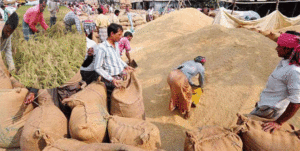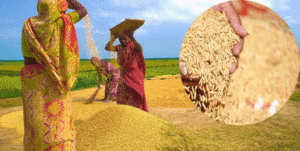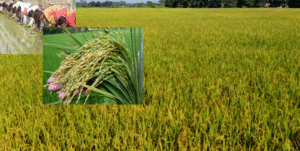
[caption id="attachment_978" align="aligncenter" width="531"] File Picture[/caption]
Desk Report: Bumper crop used to be good news for all the times, but sometimes a bumper crops can be a headache also. Which happened in Bangladesh in the previous time.
For farmers who have to wait for almost four to six months after the sowing season before they can see the fruits of their labour, there is nothing that brings more joy and hope than the sight of undulating rice paddy that holds out the prospect of a full meal after weeks of anticipation. Whether we are talking about a subsistence farmer or one who has surplus paddy to sell in the market, a good harvest ought to be good news.
It is an irony of fate that the bumper harvest in recent months has only brought hardship and destitution for our farmers. Bangladesh now has had two back-to-back bumper harvests—Aman last year and Boro this year—and government godowns are brimming with rice stock. Rice production amounted to 3.62 crore metric tons in fiscal year 2017-18, and the total production is expected to hit a new high during the current fiscal year, according to the Department of Agricultural Extension (DAE), rice millers and traders. Estimates from the US Department of Agriculture attaché in Bangladesh indicate that the production for 2018-19 is expected to increase by 6.3 percent year-on-year.
All this is good news. However, a complex set of circumstances including nature’s bounty, government policy, and an alleged entente between the politicians, rice-mill owners, and traders have now resulted in a crisis for the government just before the Eid holidays and the upcoming budget session of the new parliament.
Accounts of farmers setting fire to their harvest, protests organized by farmers’ organizations, and confusing and conflicting statements by different persons have rocked the nation over the previous time. In sum, the prosperity of our agriculture is not necessarily good news for the farmers.
It must be conceded that Bangladesh has reached an enviable milestone of food-grain self-sufficiency. However, it now appears that this cornucopia or abundance is actually not a blessing, particularly from the growers’ point of view. How can we protect our poor farmers, who apparently are going bankrupt while trying to grow this crop which is vital for our economy, so that in future we never have to face this same situation all over again? Why can’t we guarantee that both the agriculturalists and the consumers are assured of price stability that works for each?
[caption id="attachment_979" align="aligncenter" width="505"]
File Picture[/caption]
Desk Report: Bumper crop used to be good news for all the times, but sometimes a bumper crops can be a headache also. Which happened in Bangladesh in the previous time.
For farmers who have to wait for almost four to six months after the sowing season before they can see the fruits of their labour, there is nothing that brings more joy and hope than the sight of undulating rice paddy that holds out the prospect of a full meal after weeks of anticipation. Whether we are talking about a subsistence farmer or one who has surplus paddy to sell in the market, a good harvest ought to be good news.
It is an irony of fate that the bumper harvest in recent months has only brought hardship and destitution for our farmers. Bangladesh now has had two back-to-back bumper harvests—Aman last year and Boro this year—and government godowns are brimming with rice stock. Rice production amounted to 3.62 crore metric tons in fiscal year 2017-18, and the total production is expected to hit a new high during the current fiscal year, according to the Department of Agricultural Extension (DAE), rice millers and traders. Estimates from the US Department of Agriculture attaché in Bangladesh indicate that the production for 2018-19 is expected to increase by 6.3 percent year-on-year.
All this is good news. However, a complex set of circumstances including nature’s bounty, government policy, and an alleged entente between the politicians, rice-mill owners, and traders have now resulted in a crisis for the government just before the Eid holidays and the upcoming budget session of the new parliament.
Accounts of farmers setting fire to their harvest, protests organized by farmers’ organizations, and confusing and conflicting statements by different persons have rocked the nation over the previous time. In sum, the prosperity of our agriculture is not necessarily good news for the farmers.
It must be conceded that Bangladesh has reached an enviable milestone of food-grain self-sufficiency. However, it now appears that this cornucopia or abundance is actually not a blessing, particularly from the growers’ point of view. How can we protect our poor farmers, who apparently are going bankrupt while trying to grow this crop which is vital for our economy, so that in future we never have to face this same situation all over again? Why can’t we guarantee that both the agriculturalists and the consumers are assured of price stability that works for each?
[caption id="attachment_979" align="aligncenter" width="505"] File Picture[/caption]
The genesis of the current debacle can be traced to the flip-flop in our policy arena and lack of vision on the part of the various ministries involved in procurement, trade, and distribution of food grains. Our policy on import and export of rice lacked consistency. Bangladesh banned sales of some common rice varieties in May 2008 when there was a spike in domestic prices. The government has relaxed the ban in recent years, but given the lack of experience of our exporters, the availability of the export market is probably not going to ameliorate the condition of the growers. As can be expected, the current situation has led to an interesting tug of war between the government, the opposition, and outside observers.
The government announced that it will procure paddy at Tk 1,040 per maund from the farmers. But many farmers were forced to sell the paddy at Tk 500-600 per maund, which is well below the production cost, to the middlemen as the government’s procurement is delayed.
“The Boro crop production cost is estimated at more than Tk 600 (per maund), excluding the labour cost. But if the labour cost is included, the selling price should stand at Tk 1,200,” said Prof. Dr.AbulBarkat of Dhaka University. “Only fixing the government’s procurement rate at minimum 20 percent more than the production cost will not work. It must be ensured that the real farmers get that market price without any trouble.”
The lack of real-time fact-based government policy on procurement, exports, guaranteed price, and export tariffs has added to the confusion. The government has failed to listen to its own advisers. In a policy paper on procurement policy, Tawfiq-e-ElahiChowdhury and Steven Haggblade advised our government to learn from past experience, which “suggests one final lesson: clear, written policy statements may serve as an important aid in cementing a reform.”
Obviously, the increased production has created a headache for the government. The price of paddy in the open market is low and hurting the growers, and the agriculture minister rued that even if the government buys rice at Tk 36 per kg, the actual farmers are not benefitting from the purchase since the middleman are taking their cut and leaving the growers in ruins. He blamed the middlemen and their political influence for the farmer’s sorry plight and for frustrating the government’s desire to buy directly from the peasants.
[caption id="attachment_980" align="aligncenter" width="491"]
File Picture[/caption]
The genesis of the current debacle can be traced to the flip-flop in our policy arena and lack of vision on the part of the various ministries involved in procurement, trade, and distribution of food grains. Our policy on import and export of rice lacked consistency. Bangladesh banned sales of some common rice varieties in May 2008 when there was a spike in domestic prices. The government has relaxed the ban in recent years, but given the lack of experience of our exporters, the availability of the export market is probably not going to ameliorate the condition of the growers. As can be expected, the current situation has led to an interesting tug of war between the government, the opposition, and outside observers.
The government announced that it will procure paddy at Tk 1,040 per maund from the farmers. But many farmers were forced to sell the paddy at Tk 500-600 per maund, which is well below the production cost, to the middlemen as the government’s procurement is delayed.
“The Boro crop production cost is estimated at more than Tk 600 (per maund), excluding the labour cost. But if the labour cost is included, the selling price should stand at Tk 1,200,” said Prof. Dr.AbulBarkat of Dhaka University. “Only fixing the government’s procurement rate at minimum 20 percent more than the production cost will not work. It must be ensured that the real farmers get that market price without any trouble.”
The lack of real-time fact-based government policy on procurement, exports, guaranteed price, and export tariffs has added to the confusion. The government has failed to listen to its own advisers. In a policy paper on procurement policy, Tawfiq-e-ElahiChowdhury and Steven Haggblade advised our government to learn from past experience, which “suggests one final lesson: clear, written policy statements may serve as an important aid in cementing a reform.”
Obviously, the increased production has created a headache for the government. The price of paddy in the open market is low and hurting the growers, and the agriculture minister rued that even if the government buys rice at Tk 36 per kg, the actual farmers are not benefitting from the purchase since the middleman are taking their cut and leaving the growers in ruins. He blamed the middlemen and their political influence for the farmer’s sorry plight and for frustrating the government’s desire to buy directly from the peasants.
[caption id="attachment_980" align="aligncenter" width="491"] File Picture[/caption]
How do governments cope with this phenomenon which we see in Bangladesh? A common short-term response is to buy the crop from the farmers at a guaranteed minimum price. Unfortunately, a thorn on the side of the government is the interference of the politicians, the officials, and the “syndicate”.
Our policymakers have been advised time and again that procurement prices of rice, which are much higher than market prices, favour rent-seeking opportunities leading to further increase in costs for the government. “Since the bulk of rice that is procured is bought from millers or other traders, any rents would disproportionately benefit millers and traders,” said a group of researchers.
Others have warned that there is often an unholy alliance between officers of the Food Department and the millers: “There appears to be widespread abuse of public resources through collusion between millers and public officials. The current system of procurement, therefore, does not affect market prices as much as it could.”
Finally, an earlier study done by IFPRI on rice export emphasizes that its feasibility depends on a set of policy measures. 1st, our policy should create favorable conditions for the development of export markets. In addition, the process of export should be kept simple to avoid inordinate delays in completing paperwork. 2nd, existing infrastructure and equipment affecting transportation, storage, and milling should be updated and expanded. 3rd, a grading system should be introduced to raise the average quality of rice consumed domestically and to enhance the likelihood of exporting successfully in the international market. 4th, there should be research to continuously improve productivity and quality. Finally, the international market should be opened gradually so that negative effects can be absorbed smoothly. Tax and subsidy policies at the point of external trade may be effective in handling the instability of prices arising from this step.
Source: Online
File Picture[/caption]
How do governments cope with this phenomenon which we see in Bangladesh? A common short-term response is to buy the crop from the farmers at a guaranteed minimum price. Unfortunately, a thorn on the side of the government is the interference of the politicians, the officials, and the “syndicate”.
Our policymakers have been advised time and again that procurement prices of rice, which are much higher than market prices, favour rent-seeking opportunities leading to further increase in costs for the government. “Since the bulk of rice that is procured is bought from millers or other traders, any rents would disproportionately benefit millers and traders,” said a group of researchers.
Others have warned that there is often an unholy alliance between officers of the Food Department and the millers: “There appears to be widespread abuse of public resources through collusion between millers and public officials. The current system of procurement, therefore, does not affect market prices as much as it could.”
Finally, an earlier study done by IFPRI on rice export emphasizes that its feasibility depends on a set of policy measures. 1st, our policy should create favorable conditions for the development of export markets. In addition, the process of export should be kept simple to avoid inordinate delays in completing paperwork. 2nd, existing infrastructure and equipment affecting transportation, storage, and milling should be updated and expanded. 3rd, a grading system should be introduced to raise the average quality of rice consumed domestically and to enhance the likelihood of exporting successfully in the international market. 4th, there should be research to continuously improve productivity and quality. Finally, the international market should be opened gradually so that negative effects can be absorbed smoothly. Tax and subsidy policies at the point of external trade may be effective in handling the instability of prices arising from this step.
Source: Online
Comment Now